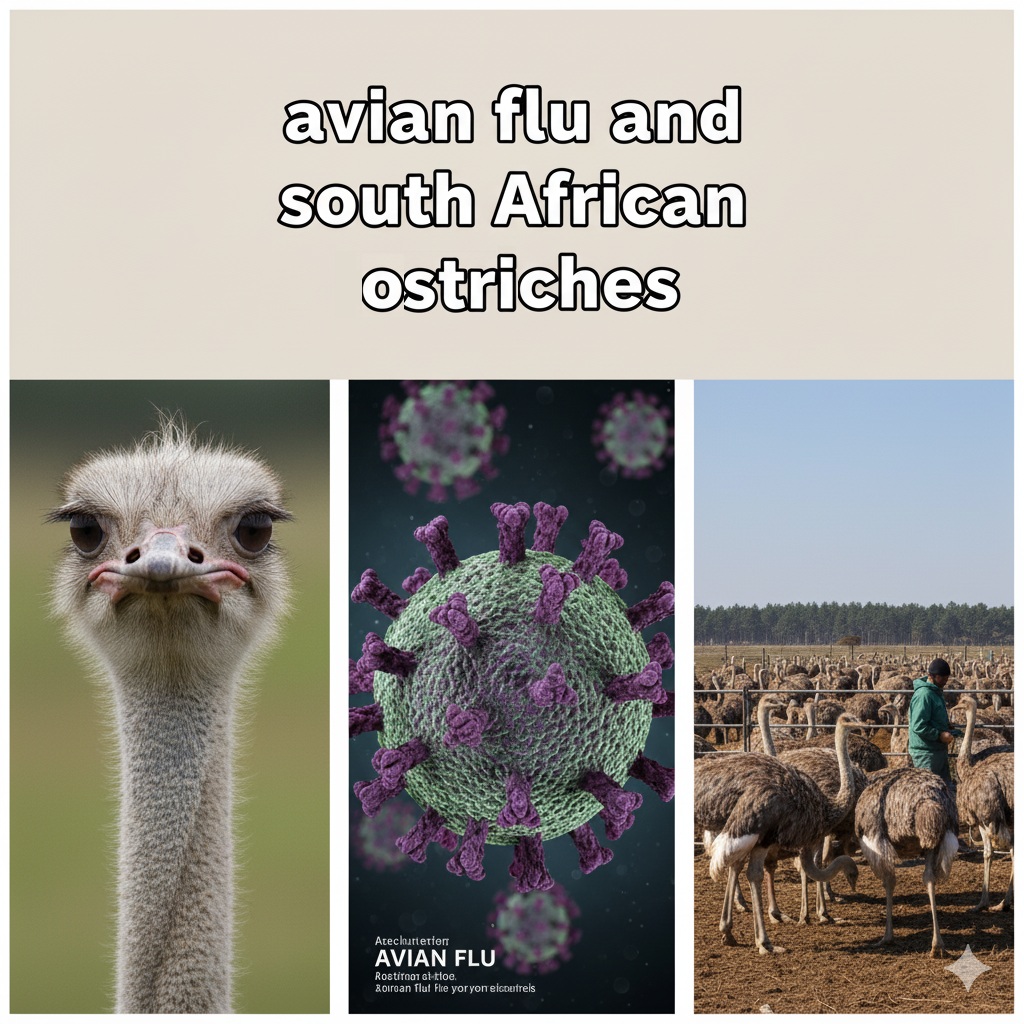
Avian flu, also called bird flu, has had a big impact on South Africa’s ostrich industry, which is one of the largest in the world. Ostriches are raised mainly in the Western and Eastern Cape provinces, covering huge farms with hundreds of thousands of birds. South Africa exports a lot of ostrich meat and products globally, so any disease affecting ostriches can have serious economic consequences for farmers and the country’s economy.
What is Avian Flu?
Avian influenza is a virus that affects birds. It spreads easily among wild birds and domestic birds like chickens, turkeys, and ostriches. Some types of avian flu are low pathogenic and cause mild illness, while others are highly pathogenic (HPAI) and can cause severe disease and death in birds.
The virus type called H5N8, for example, has caused outbreaks in South African ostrich farms along with other bird species. The disease can spread rapidly in large bird farms, where animals live close to each other. Infected birds can show symptoms like loss of appetite, breathing problems, and high mortality.
History of Avian Flu in South African Ostriches
The first significant issues with avian influenza in South African ostriches started appearing in the 1980s, with young birds showing high death rates. Over the years, different virus subtypes like H7N1 and more recently H5N8 and H6N2 have been detected on farms.
The ostrich industry recorded outbreaks in the 1990s and 2000s, which led to export restrictions and economic losses. More recently, in 2023 alone, thousands of ostriches had to be culled to control the spread of avian flu, especially in the Western Cape province’s Klein Karoo valley, the heart of ostrich farming in South Africa.
Economic and Social Impact
Ostrich farming is vital for South African agriculture and supports many local communities. When avian flu outbreaks happen, the government imposes restrictions including stopping the movement of ostriches between farms or for export. These measures help control the disease but cause big financial losses.
For example, the Klein Karoo region suffered economic losses totaling millions of rands, affecting farmers and workers who depend on ostrich breeding, meat, and leather industries. Compensation schemes exist, but farmers often find it difficult to recover from the losses fully.sanews+1
How Does Avian Flu Spread Among Ostriches?
Avian flu viruses spread mainly through contact with wild birds, especially waterfowl, which can carry the virus without showing symptoms. In South African free-range ostrich farms, birds often share water and grazing areas with wild birds, increasing the risk.
The virus spreads by droplet transmission, contaminated feed or water, and through equipment or humans moving between farms. The close contact and large populations on farms make it easier for the disease to spread quickly once introduced.
Monitoring and Controlling the Disease
South Africa’s government, private industry, and international experts actively monitor avian flu outbreaks. Tests on ostriches include swabs of respiratory and digestive tracts to detect viral infection and identify virus strains. This ongoing surveillance is crucial to catch outbreaks early and prevent wider spread.
During outbreaks, infected and exposed birds are culled to stop the virus. Farms may be quarantined to avoid spreading the disease to nearby areas. These measures are difficult but necessary to protect the broader industry.
Vaccine and Research Efforts
Scientists continue to study avian influenza viruses affecting ostriches to develop better prevention and control methods. Research includes understanding how viruses mutate and spread, and testing vaccines suited for ostriches.
Vaccines have been used in limited ways, but challenges exist because ostriches react differently than chickens, and free-range farming complicates vaccine delivery. Improving vaccines and farm biosecurity practices is a priority to reduce future outbreaks.
The Role of Wild Birds and Environment
Wild birds act as sentinels for avian viruses, often carrying them across regions without getting sick. This makes monitoring wild bird populations important, especially in areas near farms.
Seasonal factors also influence disease spread. Cooler, wetter months favor the virus’s survival outside a host, increasing infection chances. This seasonality means farms must be extra vigilant when conditions support virus persistence.
Importance of Ostrich Farming to South Africa
Ostrich farming in South Africa is a multi-million-dollar industry focused on meat, feathers, and leather. The country is among the world’s top producers and exporters. Efficient, disease-free production helps sustain jobs and economic growth in rural areas.
Avian flu outbreaks threaten this balance, with consequences beyond the farms, affecting supply chains, export markets, and food security for communities.
What Can Be Done to Protect Ostrich Farms?
Experts recommend a combination of actions to protect ostrich farms from avian flu:
- Biosecurity: Strict control of movement in and out of farms, sanitizing equipment, and minimizing contact with wild birds.
- Surveillance: Regular testing and monitoring of birds and wild bird populations for early detection.
- Culling: Swift removal of infected or exposed birds to prevent spread.
- Vaccination: Continued development and use of effective vaccines tailored for ostriches.
- Education: Informing farmers and workers about signs of disease and best management practices.
- Zoning: Using separate production zones to control movement and reduce risk.
Government and industry partnerships are key to implementing these measures efficiently.
Conclusion
Avian flu remains a major challenge for South Africa’s ostrich industry. The virus can cause high death rates in birds and force costly restrictions on trade and movement. However, ongoing research, monitoring, and biosecurity efforts help protect the birds and farmers. Compared to other poultry, ostriches pose unique challenges due to their size, farming methods, and interaction with wild birds.
By understanding how avian flu spreads and responding quickly with science-driven strategies, South Africa aims to safeguard one of its iconic agricultural resources. The health of ostriches, the economy, and rural livelihoods depends on continued vigilance and cooperation among farmers, scientists, and government agencies.
- https://www.sciencedirect.com/science/article/abs/pii/S016758772100218X
- https://pubmed.ncbi.nlm.nih.gov/16447494/
- https://www.sanews.gov.za/south-africa/thousands-ostriches-culled-avian-flu-outbreak
- https://pmc.ncbi.nlm.nih.gov/articles/PMC11209199/
- https://www.bbc.com/news/world-africa-16275280
- https://www.cidrap.umn.edu/avian-influenza-bird-flu/avian-flu-strikes-poultry-wild-birds-3-nations

Hi, There and Welcome to BirdsNews.com, is here to help you learn and care about pet birds. and this blog is a journal of everything I’ve learned.
